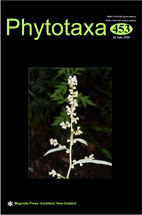Abstract
While assisting El Nido-Taytay Managed Resource Protected Area in their biodiversity monitoring of El Nido, Palawan, the authors came across a very distinctive and small population of Begonia. Based on careful investigation, the unknown species is confirmed as new to science, and is the latest addition to the species rich section Baryandra. A new species, Begonia cabanillasii is hereby described and illustrated. It is compared with phenetically similar species B. suborbiculata. Based on guidelines by IUCN, the new species is proposed to be Critically Endangered (CR) C2a.
References
de Candolle, A. (1859) Mémoire sur la famille des Bégoniacées. Annales des Sciences Naturelles. Botanique. Ser. 4 11: 93–149.
Hughes, M., Moonlight, P., Jara, A., Tebbitt, M., Wilson, H. & Pullan, M. (2015 onwards) Begonia Resource Centre Royal Botanic Garden Edinburgh. Available from: <a href="https://padme.rbge.org.uk/begonia">https://padme.rbge.org.uk/begonia</a> (accessed 16 October 2019)
Hughes, M., Rubite, R., Yoshiko, K. & Peng, C.-I. (2011) Begonia blancii (sect. Diploclinium, Begoniaceae), a new species endemic to the Philippine island of Palawan. Botanical Studies (2011) 52: 203–209.
Hughes, M., Peng, C.-I, Lin, C.W., Rubite, R., Blanc, P. & Chung, K.F. (2018) Chloroplast and nuclear DNA exchanges among Begonia sect. Baryandra species (Begoniaceae) from Palawan Island, Philippines, and descriptions of five new species. PLoS ONE 13(5):e0194877.
<a href="https://doi.org/10.1371/journal.pone.0194877">https://doi.org/10.1371/journal.pone.0194877</a>
Hughes, M., Coyle, C. & Rubite, R. (2010) A revision of Begonia section Diploclinum (Begoniaceae) on the Philippine island of Palawan, including five new species. Edinburgh Journal of Botany 67(1): 123–140.
<a href="https://doi.org/10.1017/S0960428609990266">https://doi.org/10.1017/S0960428609990266</a>
IUCN Standards and Petitions Subcommittee (2019) Guidelines for Using the IUCN Red List Categories and Criteria. Version 14. Prepared by the Standards and Petitions Subcommittee. Available from: <a href="http://cmsdocs.s3.amazonaws.com/RedListGuidelines.pdf">http://cmsdocs.s3.amazonaws.com/RedListGuidelines.pdf</a> (accessed 28 May 2020)
Klotzsch, J.F. (1855) Begoniaceen-Gattungen und Arten. Abhandlungen der Königlichen Akademie der Wissenschaften, Berlin, 135 pp. + 12 plates.
Linnaeus, C. (1753) Species Plantarum. Vol. 2. Laurentius Salvius, Stockholm, pp. 561–1200.
Pelser, P., Barcelona, J.F. & Nickrent, D.L. (Eds.) (2011 onwards.) Co’s Digital Flora of the Philippines. Available from: <a href="https://www.philippineplants.org/"><span style="text-decoration: underline;">https://www.philippineplants.org/</span></a> (accessed 20 December 2018)
Rajbhandary, S., Hughes, M., Phutthai, T., Thomas, D.C. & Shrestha, K.K. (2011) Asian Begonia: out of Africa via the Himalayas?. Gardens’ Bulletin Singapore 63 (1 & 2): 277–286.
<a href="https://doi.org/10.1186/1999-3110-54-38">https://doi.org/10.1186/1999-3110-54-38</a>
Rubite, R., Hughes, M., Alejandro, G.J. & Peng, C.-I. (2013) Recircumscription of Begonia sect. Baryandra (Begoniaceae): evidence from molecular data. Botanical Studies. Available from: <a href="https://as-botanicalstudies.springeropen.com/articles/10.1186/1999-3110-54-38">https://as-botanicalstudies.springeropen.com/articles/10.1186/1999-3110-54-38</a> (accessed 9 May 2019)
Sopsop, L.B. & Buot, I.E. (2009) The endangered plants of Palawan Island, Philppines. Asia Life Sciences 18: 251–279.

